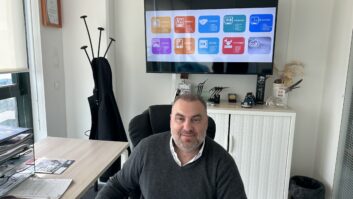
Hadfield works on site as trees that fell during a snowstorm in 2012 are cleared from the road to the KKBW tower. SEATTLE — Marty Hadfield is director of engineering for the Seattle cluster of Clear Channel Media & Entertainment, a position he’ll have held three years come June.
As part of our expanded coverage of radio information technology as well as traditional engineering management, Radio World contributor and technical advisor Thomas R. McGinley conversed with Hadfield via email about issues such as IT standards and requirements regarding hardware and software purchases, updated skill sets, organizational tools and cluster support.
In a broadcast engineering career of more than 40 years, Hadfield has had stints at Fisher, Qualcomm and Alpha, among other broadcast groups. He’s perhaps best known from a 17-year stint as corporate vice president of engineering for Entercom Communications.
Hadfield, like other group engineers these days, needs to keep up not only with changes in RF needs but with IT issues as well.
Clear Channel has seven stations — five FM and two AM — in the Seattle-Tacoma market, which is ranked by Nielsen Audio as Radio Market 13, with a Metro 12+ population of about 3.6 million people.
RW: Many chief engineers or their designated staff people are responsible for IT operations at their stations. That often includes not only the audio delivery and automation systems but also the office LAN with all of its servers, workstations and portable devices used in the facility. How is IT support handled in your operation?
Hadfield: Craig Fleek is my local IT Manager here in Seattle. He hails from the banking and real estate industries, with a degree in computer security and digital forensics — a perfect fit to maintain, plan and diagnose root cause problems. Mario Magana is our local NexGen/IT assistant. Mario’s background includes having being a producer/coordinator for the “Delilah” show and a remote broadcast coordinator. My personal involvement with IT amounts to about 20 percent of my time.
RW: To what extent does your corporate office set IT standards and requirements regarding hardware and software purchases as well as Internet and WAN services? Does your company contract with outside IT service and support providers and/or services?
Hadfield: With the best interests of WAN/LAN system security, reliability, QOS and predictable functionality across our far-flung footprint, our corporate IT managers do set well-founded and stringent system specifications for hardware and for the many enterprise-level software programs all CCM+E clusters use, but they do not generally limit the loading of any specific software on local machines. Other than specialty phone system configurations, locally we do not generally contract for outside IT support services.
RW: As IT has become so heavily integrated into broadcast operations, IT skills for engineers are critical. What specific skill sets are you looking for when hiring staff engineers?
Hadfield: First, I look at an individual’s personality, their ability to work and relate well with our other technical, general staff and members of the management team. This is really important under the sometimes stressful conditions we face when equipment fails or something goes sideways. My department is operated with a mindset that is service-oriented, similar to a help desk, where our customers are the station staff. Placing positive personality traits high on the list helps assure a good, empathetic experience with our general staff, without too much of the “… I can’t believe the user didn’t know they needed to have Caps Lock off when entering their password” type of attitude.
Then I focus on their technical capabilities relating to knowledge of the typical studio and transmitter site electronics equipment and the interconnectivity chain of the equipment. Familiar basic skills such as following instructions, grasping basic signal flow paths, soldering, connector crimping, schematic reading and a functional understanding of TCP/IP connectivity abilities must pass muster. I seek individuals who have industry certifications relating to their field of expertise.
RW: The industry has significantly downsized engineering staff sizes since 2008. What staff positions are you maintaining and how much do you rely on part-time and outside contractor help?
Hadfield: In addition to my IT team that I mentioned earlier, I am very fortunate to have my Assistant DOE and Chief Operator Bill Major. His background in broadcast engineering and commercial IT spans at least as many decades as my experience and he’s a well-rounded technical asset with strong WheatNet knowledge.
My Remote Broadcast Coordinator Terry Ryan also shares a wide skill set that includes just about all aspects of our technical operations, and he has years of experience with national network event remote broadcasting. Since my Seattle market AM/FM/microwave transmission facilities are spread out over 12 separate sites in four counties, I do have a few contract engineers available on call, and there are occasions where we hire outside contract help for large-scale remote broadcasts, special construction projects or when a snowcat is needed to access one of the six mountaintop sites.
RW: Chief engineers of multi-station market clusters need to balance their responsibilities between administration chores and meetings with hands-on time for equipment installation and repair. Give us a snapshot look at your typical workday.
Hadfield: When I wake up, one of the first things I do is check my email for urgent/semi-urgent matters. If something truly serious is going on, we have an “ASAP” phone number assigned that that sends urgent calls to me first, and if I miss the call, it rolls over to Bill [Major] and the other team members in a sequence.
During my drive into the studios, I make a few calls, hands-free through the vehicle audio system, and listen to each station on analog, HD Radio, and on iHeartRadio. I also dial around to see how the local competition sounds.

Hadfield keeps notes and sketches in a composition book with five squares per inch. To share info or save it in a different place, he snaps an image with his smartphone and sends it to himself or others. This sketch is related to data collection for a Method of Moments analysis of the support structure for an FM antenna.
Credit: Photo by Marty Hadfield I try to arrive at my office before 8 a.m., then walk through the studio area to see if anyone is having problems. To help respond to early morning challenges that seem to come up in the studios, I have set up a staggered start schedule for my technical staff. Fortunately for me, Bill arrives at about 5:30 a.m., and he has usually already put out any “first-shift fires” by the time I arrive.
I sign in and check my email, looking for Trouble Tickets [a CCM+E proprietary service-call tracking system] and prioritize them for work assignments. My management approach includes quite a bit of “Management By Walking Around,” touching base with not just my staff, but the sales, programming, production and talent. …
About 3 percent of my day is focused on invoice processing, and then the balance of my day is coaching my team members, helping with trouble shooting the more unusual challenges, going to tower sites for inspections and projects, developing both near-term and long-range plans to meet the needs of other departments. I strive to keep myself and my staff on a routine eight-hour workday at the studios and offices, which can be tough, but using good scheduling and IP remote access really helps.
RW: Digital assets like streaming, video and websites are rapidly becoming important components of station operations. To what extent do you and/or members of your staff support these?
Hadfield: CCM+E Seattle has a digital department that manages the daily operations of these assets, but my IT team and I support their inside equipment and the outbound streaming encoder systems. Once the various streams leave Seattle, their provisioning is handled by corporate.
RW: RF support and transmitter site operations require specialized skill sets. How much are you personally involved with your cluster’s transmitter sites and do you assign a staff engineer to handle these duties and/or do you use any outside the market or contract help?
Hadfield: Under non-emergency conditions, my assistant and I usually alternate site visits to make it to all of our AM and FM transmitter sites on an average of about once every two months for routine inspections, but certainly more often if indicated by remote control monitoring. I usually keep contract-type engineers in a standby mode for emergencies and occasional site inspections.
RW: The need for afterhours and emergency engineering support can be challenging, especially for small staffs. How do you handle this critical function at your stations?
Hadfield: I strive to eliminate or reduce the drive time it takes us to support our equipment when we are not in the office. I believe in maximizing the remote monitoring and control of as many of our technical systems as possible, via a secure, localized version of the “Internet of Things” concept, which includes the use of inexpensive IP-controlled outlets to cold-boot some types of equipment. This approach helps me manage some of my own stress factors, as well those of my technical support team members.
RW: Beyond a smartphone, what hardware and software tools do you rely on most to stay organized and efficient while performing your duties?
Hadfield: Most importantly for me, I keep my daily activity notes in a graph ruled “composition book” with five squares per inch. This allows me to make quick sketches, jot down phone notes, make references to someone’s requests, and local weather conditions that may impact some aspect of operations. To share the info or store it in a different place, I snap an image with my smartphone and send it to myself or others.
I’m using the video/audio capture feature of my smartphone a lot. One good use I found when performing a generator test is to start rolling video of the control panel before you first start the engine. If it coughs and sputters, clanks, shows wild voltage variations or whatever, you can share the AV clip with your generator service company and they may be able to trouble shoot the condition remotely and then be able to bring exactly what service items are needed when they visit.
I use Gantt charts and Outlook calendars to help plan and track projects. CCM+E Corporate offers access to many efficiency tools, including an internal Wiki that is fed by the experiences of all of our engineering and IT members.
RW: How do you see the role of chief or market engineer changing? To what extent can contractors or corporate based engineering services and regional personnel replace local engineers to support stations’ technical needs?
Hadfield: I think most companies have already seen the duties of their CE/market engineer mature to a point where there are very few aspects of a radio station’s operations that are not already touched by them. When the operating budget demands a reduction of local engineering staff, the station general management must face the fact that response and recovery times will be increased and their menu of options for remote broadcasts, studio change requests and other tasks that require physical involvement, will be reduced, too.
In order to efficiently use any form of engineering services, if it hasn’t happened already, the chief engineer needs to develop a thorough set of current, descriptive and pictorial plans of the signal paths that exist within their facilities. This guide must include IP, analog and control signal paths, with equipment models (another good place to insert an image of a device) and the I/O wiring connection descriptions — numbers and a brief to/from description are what I appreciate the most when I look at cables spilling out of an IP switch or and EAS box.
Standardizing and documenting network user drive paths and IP address or machine names will minimize confusion when a PC/server hiccups. This collection becomes a living resource guide to assist in accelerating trouble shooting of the facilities when the CE is unavailable and contractors or other help will have to step in.
RW: The ranks of senior engineers are dwindling daily as more of us are retiring or choosing to pursue other opportunities. How are preparing your stations for the eventual transition to a new cluster chief?
Hadfield: I am an advocate and practitioner of cross-training. Both of my IT team members are starting to take basic electronics courses to bridge and broaden their knowledge base to become familiarized with transmitter site equipment operation and maintenance. This method certainly does not bear fruit overnight, but coupled with their on-the-job knowledge of the overall facilities, they will have improved their likelihood of being primary candidates when the position is eventually open.
From the corporate side, earlier this year CCM+E announced the completion of its inaugural Market Engineering Manager Development Program, and we are in the third year of the Electrical Engineering Co-op Program. In addition to looking within my staff and the CCM+E engineering talent pool across the nation, I feel the pulse of potential applicants by staying in touch with smaller market engineers and with students at university and local vocational schools.
RW: How did you get into radio?
Hadfield: I have lived and worked in Seattle and the great Pacific Northwest my whole career. My first paying job in radio was working at a tower site, logging transmitter readings every hour. It was around 1973 and the DC remote control lines had failed. I held a third Class Operator Permit, so my friend Ernie Opel, chief engineer at KBLE(FM), Seattle — now one of my Seattle stations, KUBE — asked if I could take on the job.
Comment on this or any story. Write to [email protected].











